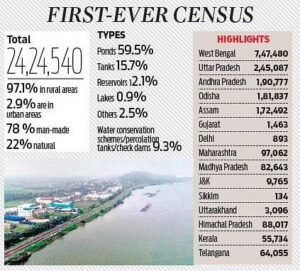Published on: April 25, 2023
‘Irrigation Census’
‘Irrigation Census’
Why in news? According to the ‘Irrigation Census’, the first-ever comprehensive census of water bodies, by the Ministry of Jal Shakti to evaluate the water security situation, India has 24,24,540 water bodies, out of which 97.1 per cent (23,55,055) are in rural areas and 2.9 per cent (69,485) are in urban areas.
Highlights:
- The census, was launched in convergence with the 6th Minor Irrigation Census, provides a comprehensive inventory of India’s water resources, including natural and man-made water bodies like ponds, tanks, lakes, and more.
- The census was launched under the centrally sponsored scheme
- The census also highlighted disparities between rural and urban areas and varying levels of encroachment and revealed insights into the country’s water resources.
- According to ministry sources, the survey was undertaken with the aim to identify, evaluate, conserve and preserve the water bodies as water is “an important aspect for development which is linked with every Sustainable Development Goal”.
- The census has released information on all important aspects of the water bodies, including their type, condition, the status of encroachments, use and storage capacity and status of filling up was collected.
- The survey took into account all uses of water bodies like irrigation, industry, pisciculture, domestic and drinking, recreation, religious, groundwater recharge, etc.
- Census has been successfully completed and the pan-India and state-wise reports have been published.
Key features of the census:
- Out of over 25 lakh active water bodies in the country, rural India accounts for about 97 per cent and only 3 per cent are active in urban areas, according to India’s first-ever census of water resources.
- It revealed that 78 per cent of water bodies are man-made whereas 22 per cent are natural water bodies and 1.6 per cent (38,496) of water bodies have been encroached upon.
- Top 05 States in terms of number of water bodies are West Bengal, Uttar Pradesh, Andhra Pradesh, Odisha and Assam which constitute around 63% of the total water bodies in the country.
- Top 05 States in terms of number of water bodies in urban areas are West Bengal, Tamil Nadu, Kerala, Uttar Pradesh and Tripura, whereas in rural areas, top 05 States are West Bengal, Uttar Pradesh, Andhra Pradesh, Odisha and Assam.
- 5% of water bodies are ponds, followed by tanks (15.7%), reservoirs (12.1%), Water conservation schemes/percolation tanks/check dams (9.3%), lakes (0.9%) and others (2.5%).
- 2% of water bodies are owned by private entities whereas 44.8% of water bodies are in the domain of public ownership.
- Out of all public owned water bodies, maximum water bodies are owned by Panchayats, followed by State Irrigation/State WRD.
- Out of all private owned water bodies, maximum water bodies are in hands of Individual owner/farmer followed by group of individuals and other private bodies.
- Top 05 States which lead in the private owned water bodies are West Bengal, Assam, Andhra Pradesh, Odisha and Jharkhand.
- Out of all ‘in use’ water bodies, major water bodies are reported to be used in pisciculture followed by Irrigation.
- Top 05 States wherein major use of water bodies is in pisciculture are West Bengal, Assam, Odisha, Uttar Pradesh and Andhra Pradesh;
- Top 05 States wherein major use of water bodies is in irrigation are Jharkhand, Andhra Pradesh, Telangana, West Bengal and Gujarat.
- West Bengal has the highest number of ponds and reservoirs, whereas Andhra Pradesh has the highest number of tanks.
- Tamil Nadu has the highest number of lakes and Maharashtra is the leading state with water conservation schemes.
What is a Water body?
- The census defines a water body as all natural or man-made units bounded on all sides with some or no masonry work used for storing water for
- Irrigation or
- Other purposes (example industrial, pisciculture, domestic/drinking, recreation, religious, groundwater recharge, etc).
- Water bodies are usually of various types known by different names like tank, reservoirs, ponds and bundhies, etc.
- A structure where water from ice-melt, streams, springs, rain or drainage of water from residential or other areas is accumulated will also be treated as a waterbody.
The need for the census:
- With the availability of water being limited and the gap between the supply and demand widening over time, concerted efforts are needed to conserve and preserve these water bodies.
- Water being a critical element, the Ministry of Jal Shakti which is the nodal ministry for laying down policy guidelines and programmes for the development, conservation and management of water as a national resource.
Measures taken by the Ministry of Jal Shakti:
- The Ministry has multidimensional approach towards water sector, on one hand it is spearheading the ambitious programmes on providing safe and adequate drinking water to every household in the country, eliminating open defecation in rural areas, rejuvenation of river Ganga and its tributaries, improving the safety and operational performance of existing dams, etc and on the other hand, it is involved in assessment, development and regulation of the country’s water resources through technical guidance, scrutiny, clearance and monitoring.
Way ahead:
- There is the need for taking necessary steps for keeping all the water bodies encroachment free, such as
- Inclusion of water bodies in land records,
- Making them integral part of town planning process,
- Strict action for the encroachers, etc.

